How to Get Rid of Beetles in the Garden (With Pictures)
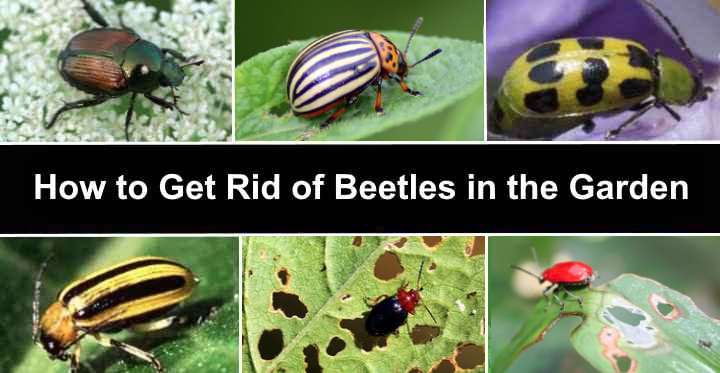
Many types of beetles can be significant garden pests. So knowing how to get rid of beetles in the garden is crucial to protect your flowers, shrubs, ornamentals, lawn, and plants from beetle damage. Destructive garden beetles chew holes in leaves, feed on roots, and can kill plants. However, the good news is that there are many natural ways to keep beetles away from your yard.
Getting rid of beetles in the garden requires a multi-targeted approach. For example, the first step is killing as many pesky garden beetles as possible. These beetles include Japanese beetles, cucumber beetles, Colorado potato beetles, and flea beetles. But you should also take control measures to prevent beetles from laying eggs, hatching, and developing into adults.
Ways to get rid of beetles in the garden include hand-picking them, using home remedy sprays, and beetle traps. Additionally, you can use row covers, beetle-repelling plants, and good gardening practices to prevent beetles from causing havoc in your garden.
This article will discuss how to get rid of beetles in the garden using various natural methods.
How to Identify Garden Beetles
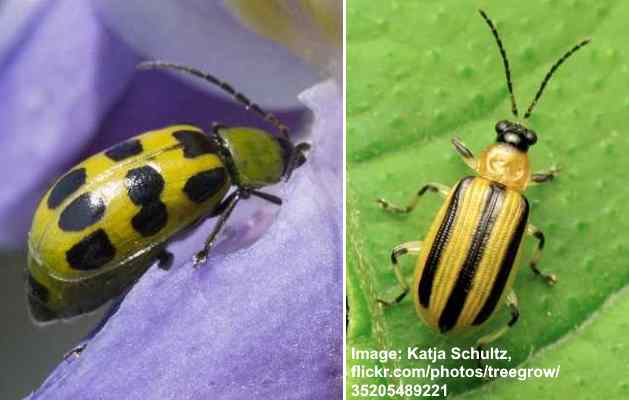
Spotted cucumber beetle (Diabrotica undecimpunctata) on the left, and striped cucumber beetle (Acalymma vittatum), on the right, spend most of their life underground munching on the roots of cucumbers, pumpkins, watermelons, squash, and zucchini
Adult beetles are typically easy to spot in a garden landscape. Most beetles in the garden have oval or round bodies, small heads, six legs and a pair of antennae.
Beetles can be identified by their color, patterns, size, and their hard shell. Beetles can have different colors such as black, iridescent green, or have mottled patterns. Although most beetles have wings, they are typically poor fliers.
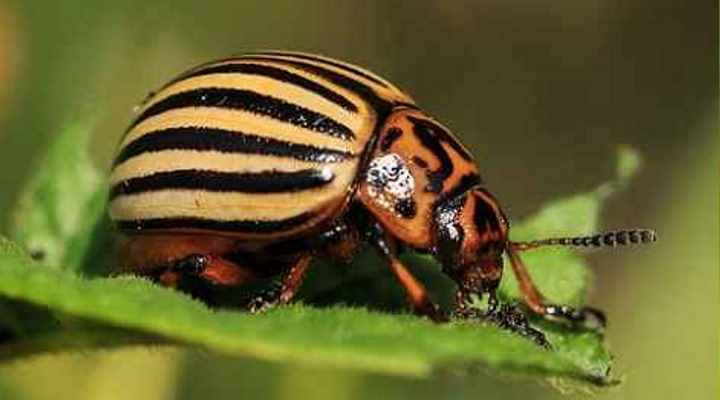
Colorado potato beetle (Leptinotarsa decemlineata) can do major damage to potatoes and other plants in the nightshade family
When identifying a beetle species, you must know where to look. For example, many kinds of beetles live on the soil surface, under garden debris and rocks. You will find other pesky beetles on plant stems or crawling underneath leaves.
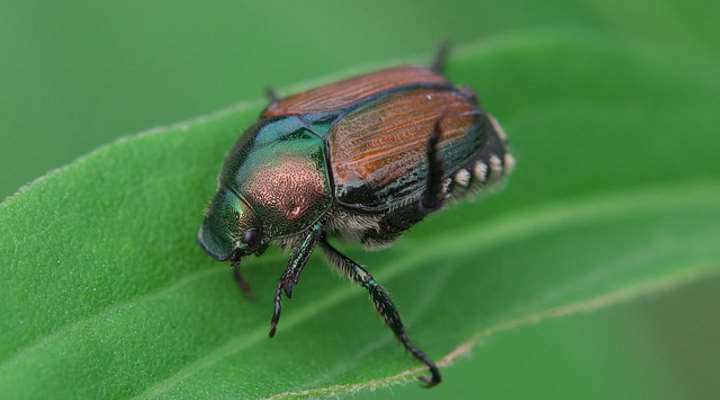
Japanese beetles (Popillia japonica) are destructive pests that feed on plant foliage, destroying the leaves of many ornamental plants, trees, and shrubs
It’s good to remember that not all beetles you find in the garden are nasty, plant-eating pests. Many garden beetles, like ground beetles and ladybugs, are beneficial insects, some of which feed on pesky bugs like aphids, caterpillars, thrips, slugs, and weevils.
For example, ground beetles feed on adult pests and larvae. Also, most species of ladybugs prey on small flying insects and their larvae.
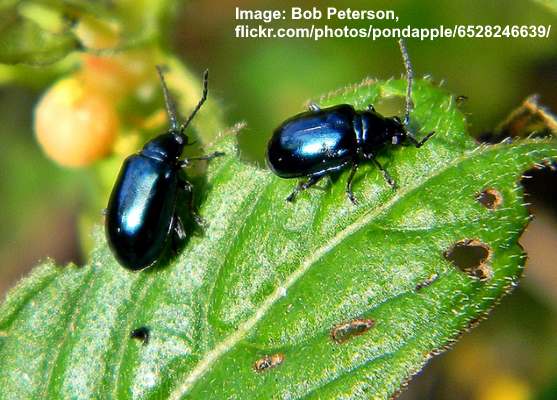
Metallic blue flea beetles (Alticini) chew on a leaf. Flea beetles include various species with different coloration
Therefore, accurate beetle identification is necessary to avoid killing the wrong type of beetle in your yard.
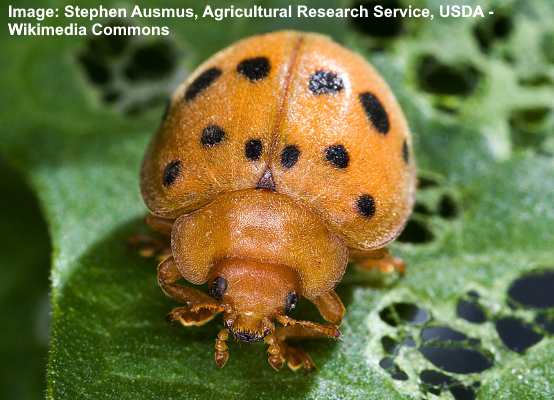
Mexican bean beetles (Epilachna varivestis) is a serious pest in vegetable gardens that can damage the leaves of legume crops, including snap beans, lima beans, soybeans, peas and lentils
What Attracts Beetles to My Yard?
The first step in knowing how to get rid of beetles is to understand what attracts them in the first place. Like most insects, moisture and food attract beetles. Therefore, try to remove pools of standing water or fix leaky pipes and gutters. Additionally, fruit trees, blooming flowers, and certain plants are preferred food sources for beetles.
In some cases, the pesky beetles seem to appear from nowhere. This is because many beetle species overwinter in the ground or under mulch and lay eggs in the soil. Therefore, some adult beetles emerge from the ground in spring after hatching and pupating underground.
Reducing the number of annoying beetles in the garden also prevents issues with beetle infestations in your home.
Signs of Beetle Damage in the Garden
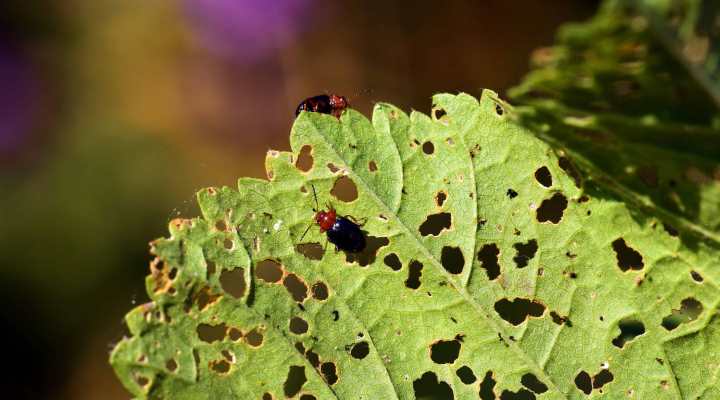
Flea beetles damage
Some species of destructive green, brown, or black beetles can cause extensive damage to gardens and landscapes.
For example, flea beetles, scarab beetles, Mexican bean beetles, and Colorado potato beetles feed on plant foliage, causing holes in leaves and creating a lacy appearance. Sometimes, the first sign of beetle damage is wilted leaves before holes appear.
Signs of Japanese beetles in a yard also include skeletonized leaves and flowers. However, because the beetle grubs live in lawns, they can destroy grass and leave brown patches when they feed on the roots.
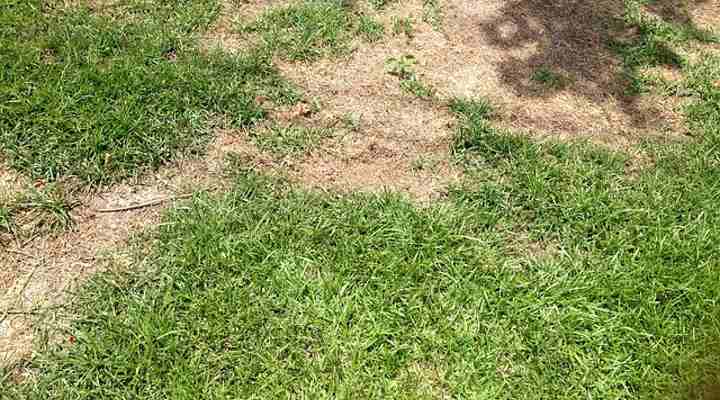
Grub damage to lawn looks like irregular patches of dead grass or bare soil
How to Get Rid of Beetles in the Garden
Getting rid of beetles in the garden requires a multi-method approach. Effective garden beetle elimination with home remedies requires persistence, determination, and some ingenuity. So let’s look at ways to win your battle to eliminate beetles, bugs, and other pests in your garden.
Hand Pick Beetles From Plants
Hand-picking the six-legged creatures from stems and leaves is the first step in eliminating plant-eating beetles from your garden. So check shrubs and ornamentals for beetle activity in late spring and early summer. Give the plants a gentle shake to make the beetles fall off. Then pick them up and drop them into a jar or bucket of soapy water.
Vigilance is necessary when removing beetles by hand. Therefore, you will need to check plants for signs of beetles every few days. Then, continue picking the beetles from plants for as long as the infestation lasts.
Use Neem Oil Spray to Kill Beetles in the Garden
Spray a neem oil solution on beetles to eradicate the pesky insects. To make a beetle spray, combine 2 tsp. neem oil, 1 tsp. liquid Castile soap, and 1 quart (1 l) of water. Pour into a spray bottle and shake the mixture thoroughly. Next, liberally spray the neem oil solution on plants affected by beetles.
For best results, you should spray neem oil on beetles and other bugs every seven days. Then, continue treating the plants with the home remedy until the beetles have left your plants for good.
How does neem oil spray kill beetles? Neem oil contains a natural insecticide and repellent called azadirachtin. According to scientific research, neem oil affects the growth and feeding behavior of many insects, including beetles. Additionally, neem oil repels beetles, preventing them from feeding on plants. With some beetle species, neem oil kills the bugs on contact.
Neem oil is also an effective solution to kill beetle grubs. For example, you can mix 2 tbs. neem oil in a gallon (3.7 l) of water and apply to a lawn every seven days. The natural insecticide stops the larvae from developing into adult beetles.
Vegetable Oil Spray
Another home remedy to rid your garden of annoying beetles is to make a vegetable oil insect spray. This involves mixing vegetable oil, dish soap, and rubbing alcohol. The oil and the alcohol combine to smother garden beetles, eventually killing them.
To make a vegetable oil spray for beetles, mix a cup of vegetable oil, a teaspoon of liquid dish soap, and a quart (1 l) of water in a large 1.5-quart spray bottle. Add a cup of rubbing alcohol and shake vigorously to emulsify the ingredients.
Spray beetles on infested plants every ten days to eliminate them and stop them from causing more damage. As you spray, you can also hand-pick any beetles you come across. Then either crush them in your hand or drop them into soapy water.
Garlic Spray as a Beetle Repellent
Garlic has a characteristic pungent aroma that acts as an insect repellent. Unfortunately, there is no evidence that garlic kills beetles and their grubs. However, the strong sulfuric stench should prevent beetles from viewing shrub foliage as a tasty treat.
To make a beetle-repellent spray using garlic, take two whole garlic bulbs and puree them in a blender with a little water. Next, pour into a jar, seal the lid tight, and leave to sit overnight. After that, strain the garlic base into a quart (1 l) jar and add half a cup of vegetable oil and a squirt of liquid dish soap. Finally, add enough water to fill the jar.
To use the insect repellent, mix a cup of the garlic solution with a quart (1 l) of water. Then, liberally use a spray bottle to cover the foliage of plants affected by beetles. Use the home remedy as a beetle repellent once a week to help win the battle with unwanted bugs in your garden.
Use Insecticidal Soap on Shrubs to Kill Beetles
A spray containing organic insecticidal soap can kill adult beetles on contact. Insecticidal soap contains fatty acids and potassium salts that help break down the cell membranes of insects. However, for insecticidal soap to work and eliminate beetles, you must spray the solution directly on the insects.
Buying a commercial product is the best way to use insecticidal soap for beetle control. Many organic insecticidal soaps are suitable for killing beetles and other unwanted bugs in the yard. To make the solution, follow the manufacturer’s instructions.
It’s good to remember that insecticidal soap can also kill beneficial insects in the garden. Therefore, you should use it carefully only when you have correctly identified the beetle species.
Set Beetle Traps in the Yard
Beetle traps can help to control the number of pesky creatures in your garden. The traps work by using pheromones to attract and catch male beetles. The idea is that the trapped beetles cannot mate with females, thus helping to reduce their population. Setting the trap away from the targeted plants is key to being effective.
It is good to keep an eye on the number of beetles you catch in the trap. This is because the pheromone traps may attract bugs and insects from further afield. And the last thing you want is to have more beetles than before. Therefore, pheromone traps are best used in large, extensive gardens.
Use Leaf Vacuum to Destroy Beetles in Garden
If you have a leaf blower with a vacuum attachment, you could suck beetles from shrubs and kill them in soapy water. A garden vacuum can be an effective way to remove a large number of beetles in a short time. After vacuuming them, empty the leaf bag into a bucket filled with soapy water to drown the unwanted pests.
It’s good to note that removing beetles with a vacuum is only a temporary solution. If you don’t take preventative measures, the beetles may return and continue causing damage to your ornamentals, flowers, and shrubs.
Diatomaceous Earth Can Help Eradicate Beetles and Other Bugs
Applying diatomaceous earth (DE) to plant leaves, stems, and on the ground can help to get rid of beetles for good. Diatomaceous earth is a white natural mineral with an abrasive texture that destroys a beetle’s exoskeleton. This causes the small round bugs to dehydrate and eventually die.
Diatomaceous earth is only effective for beetle control in dry conditions. Therefore, apply the white powdery substance only when the ground and plants are dry. Also, you must reapply DE after rainfall and when the ground has had time to dry completely.
Because diatomaceous earth is best used to control beetles in dry conditions, it is an effective solution if you have small brown beetles in the house.
Use Row Covers to Prevent Beetle Damage on Crops
Row covers are an effective and economical way of stopping cucumber beetles, Japanese beetles, and other annoying bugs from eating holes in plant leaves. You should keep the covers over your vegetables from planting until they bloom. Then you should remove them for pollination to ensure a bumper crop.
The peak feeding time for most beetles is mid-June to mid-August. Therefore, row covers are also useful during these times. The specially designed protective material lets in light and some moisture but keeps bugs like beetles, caterpillars, and other pests away.
How to Use Milky Spore, Nematodes and BT for Beetle Control in the Garden
Milky spores (Paenibacillus popilliae) and nematodes effectively prevent lawn damage caused by Japanese beetle larvae. These bacteria infect beetle lawn grubs and kill them within 7 to 21 days. As the bugs decay in the turfgrass, the milky spores release billions of new spores into the soil, thus helping to protect your lawn naturally for many years.
Nematodes are another natural beetle control method if you have problems with Japanese beetles. The parasitic organisms feed on beetle grubs and eventually kill them. Follow the manufacturer’s instructions to make a soil drench for the best results. Then apply the solution on cloudy days during spring when beetle larvae are active in the soil.
Another way of getting rid of beetles naturally is to use a specific strain of Bacillus thuringiensis (BT). Some of these bacteria strains directly target scarab beetle larvae. The best time to apply a BT solution is in early to mid-summer.
Water and Dish Soap Spray to Eradicate Garden Beetles
It is said that you can kill beetles in the garden by creating a homemade spray using dish soap.
The theory of using dish soap spray on bugs in the garden is that the soap destroys the insect’s waxy coating. This should cause the pests to dehydrate, wither, and die. Unfortunately, this method rarely succeeds with beetles because of their hard elytra (wing covers). However, you can use dish soap spray to kill other bugs in the garden.
Grow Beetle-Repelling Plants in Your Yard
Companion planting using plants that repel beetles could help prevent them from chewing your prized vegetables and ornamentals. Plants with pungent aromas or bitter-tasting leaves deter beetles from foraging nearby. Therefore, they may stay away from plants.
Here are some plants that can act as beetle deterrents:
- Onions (Allium cepa)
- Basil (Ocimum basilicum)
- Catmint (Nepeta)
- Garlic (Allium sativum)
- Mint (Mentha)
- Wormwood (Artemisia ludoviciana)
- Calendula (Calendula officinalis)
Practice Beetle Prevention Techniques in the Garden
If beetles are a problem in your area, being vigilant throughout the year is vital. For example, after planting vegetables, you should protect them with row covers until they bloom. Also, check shrubs and ornamentals early in the season to spot the first signs of possible beetle activity. Then, use natural sprays like neem oil or vegetable oil to kill adult beetles.
However, after the season, removing all garden debris where beetles like to overwinter is vital. Also, tilling the soil can help to reduce the number of harmful beetles in your garden. For example, a study found that tilling the soil in the fall and early spring reduced the number of Japanese beetle larvae by 50 percent.
Related articles:
